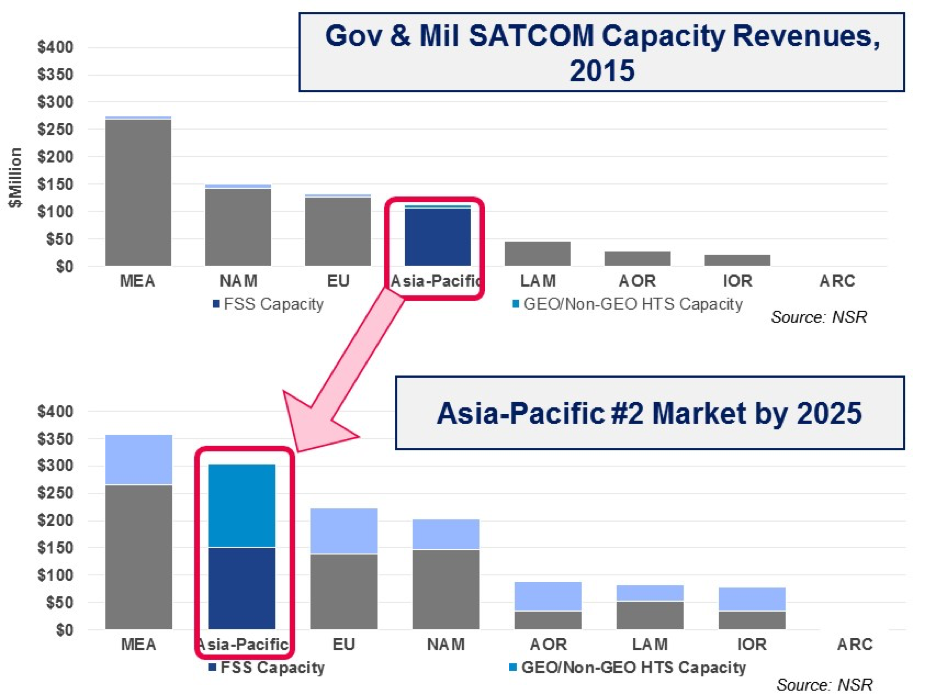|
X-(Band) Marks the Spot in Asia-Pacific
Feb 2nd, 2017 by
Brad Grady, NSR
On the footsteps of the successful launch of Japan’s DCN-2
satellite with its X-band payload (Japan’s first dedicated MILSATCOM
satellite), a new resurgence of MILSATCOM capabilities is on the
horizon. While NSR already covered some of the challenges
in larger proprietary military satellite constellation replenishments
such as “WGS 2.0” and “Skynet 6”,
new ‘players’ are entering the market looking to provide their own
capabilities.
Japan’s DCN program is one such example of nation-states
looking to provide their own capabilities. While the DCN
program uses a Public Finance Initiative (PFI) model in the same vein as
the UK’s Airbus D&S owned and operated Skynet-5 constellation, the
primary customer for the DCN program is the Japanese Self Defense
Forces. Focused on delivering capacity over the Asia-Pacific
and Indian Ocean regions (where Japanese Forces operate the most),
the capacity will help provide additional throughput in an
increasingly tense region. Just as China is expanding
their ‘blue water’ operations in the South China Sea, increasing force
projection capabilities through their new aircraft carrier, building new
relationships with traditional U.S.-allies such as the Philippines, and
on-going tensions between the U.S.-China – a serious question should be
on the minds of all players in the military and government satellite
markets: Are we finally going to see a ‘pivot to Asia’?

The “short answer” is that the Middle East & Africa will
remain a core-market for the vast majority of military and
government satellite communications demand, and the most significant
source for capacity revenues from 2015 – 2025.
According to NSR’s Government and Military Satellite
Communications, 13th Edition, despite changing dynamics
on the ground – from troop draw-downs to changing capacity pricing – the
Middle East & Africa generated almost $275 Million in capacity revenues
in 2015, and will increase to $360 Million annually by 2025. Yet,
the growth story for capacity revenues from Gov & Mil markets will be
within Asia-Pacific.
Looking at Asia-Pacific, capacity revenues between 2015 – 2025 will
increase by more than $190M – greater than both Europe and Middle East &
Africa. Why do we see such growth from Asia-Pacific?
Just as we have seen with the Japanese launch of the DSN
dedicated military satcom system, ongoing and increasing tension within
the region is spurring the deployment of airborne, maritime, and other
Gov & Mil assets into the region. Driven by the need for ISR and
C2-type applications, which capacities and which markets will help drive
growth in Asia Pacific?

For FSS capacity, X-band will be the ‘growth story’ for
Asia-Pacific, with bulk leasing applications – where
governments lease ‘raw capacity’ to support their own networks – leading
the charge for growth. The growth comes at the expense of a
shifting preference from FSS C-band capacity and FSS Ku-band capacity
towards HTS, FSS Ka-band, and FSS X-band. As more focus is given
towards operating in a ‘contested’ environment and allied
interoperability, FSS X-band represents a strong value
proposition within Asia-Pacific.
Just as nation-States invest in increasing X-band capacity in the
region like Japan’s DSN, the system joins other X-band capacity from the
UK’s Skynet and the USA’s WGS constellations. Although within the
Gov & Mil FSS markets there is a clear growth story for X-band, the
impact from GEO and Non-GEO HTS is not to be underestimated.
With a net-growth of almost 28 Gbps from HTS capacity between 2015 –
2025, HTS capacity revenues and FSS Capacity revenues will be
nearly equal by 2025. Unlike the FSS X-band story where
bulk leasing plays a significant role, HTS capacity demand comes from
managed services – providing ‘end-to-end’ networks to maritime, UAS and
manned aero platforms operating within the region. With 9 Gbps of
demand on GEO-HTS Ka-band capacity, of which some will use terminals
that are compatible with other military systems such as WGS,
there is a clear sign that designing commercial systems to work
alongside proprietary military systems is a winning combination.
Bottom Line
With compatibility with a growing number of proprietary military
satellite systems covering Asia-Pacific today and over the next ten
years, there is clear demand for designing and deploying systems
compatible with these networks. Although Ku-band in FSS and HTS for
Asia Pacific will be a significant source of capacity demand and
revenues, FSS X-band offers this compatibility, and it should be on the
spot for Asia-Pacific growth in the coming decade.

|

